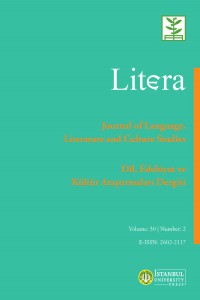Öz
Kaynakça
- Bacevich, A. J. (2009). Best intentions: an appreciation of Graham Greene (Vol. 172, No. 1, pp. 93-98). World Affairs.
- Boes, T. (2006). Modernist studies and the Bildungsroman: A historical survey of critical trends (3(2), pp. 230-243). Literature Compass.
- Bush’s Vietnam Fantasy. (2007). CHINA HAND. https://www.counterpunch.org/2007/08/28/bush-s-vietnam-fantasy/
- Bushnell, W. S. (2006). Paying for the Damage: The Quiet American Revisited (36(2), pp. 38-44). Film & History: An Interdisciplinary Journal of Film and Television Studies.
- FilmKunst (2019). Michael Caine on “The Quiet American” (2003) [Video]. YouTube. https://www.youtube.com/watch?v=aVs8dDJeEOc
- Greene, G. (2010). The quiet american. Random House.Hadar, L. (2013). How Do You Say “Quagmire” In French?. The American Conservative. https://www.theamericanconservative.com/articles/how-do-you-say-quagmire-in-french/
- Lewis, K. (1998). The Third Force: Graham Greene and Joseph L. Mankiewicz’s” The Quiet American” (10(4), pp. 477-491). Film History.
- Logevall, F. (2012). Embers of war: The fall of an empire and the making of America’s Vietnam. Random House.
- Miller, L. (2004). “God save us from the innocent and the good”. Salon. https://www.salon.com/2004/10/23/greene_2/
- Rollins, P. C., & O’Connor, J. E. (2008). Why we fought: America’s wars in film and history. University Press of Kentucky.
- Ruane, K. (2012). The Hidden History of Graham Greene’s Vietnam War: Fact, Fiction and The Quiet American (97(327), pp.431-452). History.
- Tang, J. (2003). “Bush is the ultimate Alden Pyle”. Salon. https://www.salon.com/2003/02/11/noyce/
- Zacharek, S. (2003). “The Quiet American”. Salon. https://www.salon.com/2003/01/29/quiet_american/
Öz
This paper explores the three reception phases of the story The Quiet American – the 1955 novel by Graham Greene, its first film adaptation by Joseph L. Mankiewicz in 1958 starring Michael Redgrave, Audie Murphy, and Giorgia Moll, and the later adaptation from 2002, directed by Phillip Noyce and starring Michael Caine, Brendan Fraser, and Do Thi Hai Yen. In this sense, it aims to understand the reactions, appropriations, and the chronological depictions associated with each of the three works, and to present the story of the “third force” in the context of the Rule of the Three (omne trium perfectum). As such, the principle of the Rule of the Three presents the three main characters, coming from three contrasting countries with diverging foreign policy aims, in three complex dimensions (historical, cinematographic/artistic, and political/ individual). The findings suggest that the time of release, the cast, as well as the individual spin of specific historical events have granted each of the three works very distinct results. Ultimately, their legacies witnessed disproportionate peaks of success, with some being categorised as persistent rather than particular. Without being mutually exclusive, both the novel and the two respective movies have succeeded in informing, educating, and entertaining the public about the socio-political quagmire that marked the 1950s turmoil in Việt Nam.
Anahtar Kelimeler
Việt Nam third force rule of the three quagmire United States of America
Kaynakça
- Bacevich, A. J. (2009). Best intentions: an appreciation of Graham Greene (Vol. 172, No. 1, pp. 93-98). World Affairs.
- Boes, T. (2006). Modernist studies and the Bildungsroman: A historical survey of critical trends (3(2), pp. 230-243). Literature Compass.
- Bush’s Vietnam Fantasy. (2007). CHINA HAND. https://www.counterpunch.org/2007/08/28/bush-s-vietnam-fantasy/
- Bushnell, W. S. (2006). Paying for the Damage: The Quiet American Revisited (36(2), pp. 38-44). Film & History: An Interdisciplinary Journal of Film and Television Studies.
- FilmKunst (2019). Michael Caine on “The Quiet American” (2003) [Video]. YouTube. https://www.youtube.com/watch?v=aVs8dDJeEOc
- Greene, G. (2010). The quiet american. Random House.Hadar, L. (2013). How Do You Say “Quagmire” In French?. The American Conservative. https://www.theamericanconservative.com/articles/how-do-you-say-quagmire-in-french/
- Lewis, K. (1998). The Third Force: Graham Greene and Joseph L. Mankiewicz’s” The Quiet American” (10(4), pp. 477-491). Film History.
- Logevall, F. (2012). Embers of war: The fall of an empire and the making of America’s Vietnam. Random House.
- Miller, L. (2004). “God save us from the innocent and the good”. Salon. https://www.salon.com/2004/10/23/greene_2/
- Rollins, P. C., & O’Connor, J. E. (2008). Why we fought: America’s wars in film and history. University Press of Kentucky.
- Ruane, K. (2012). The Hidden History of Graham Greene’s Vietnam War: Fact, Fiction and The Quiet American (97(327), pp.431-452). History.
- Tang, J. (2003). “Bush is the ultimate Alden Pyle”. Salon. https://www.salon.com/2003/02/11/noyce/
- Zacharek, S. (2003). “The Quiet American”. Salon. https://www.salon.com/2003/01/29/quiet_american/
Ayrıntılar
| Birincil Dil | İngilizce |
|---|---|
| Konular | Sanat ve Edebiyat |
| Bölüm | Araştırma Makaleleri |
| Yazarlar | |
| Yayımlanma Tarihi | 23 Aralık 2020 |
| Gönderilme Tarihi | 5 Mayıs 2020 |
| Yayımlandığı Sayı | Yıl 2020 Cilt: 30 Sayı: 2 |


